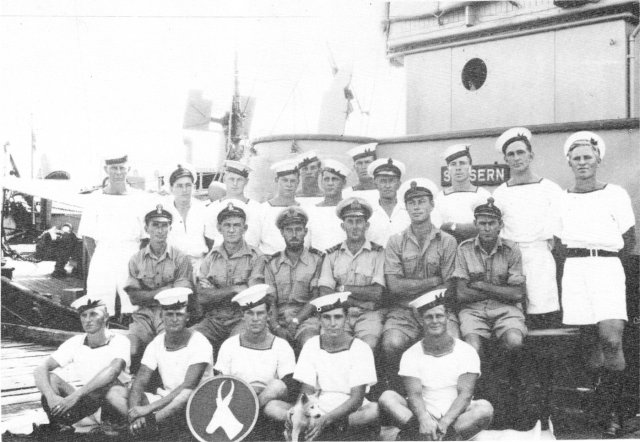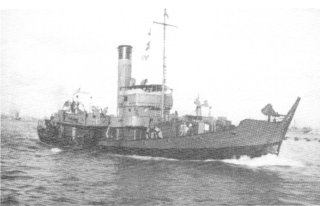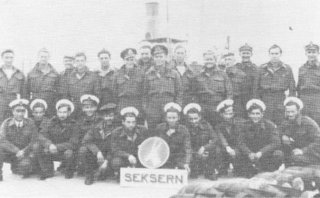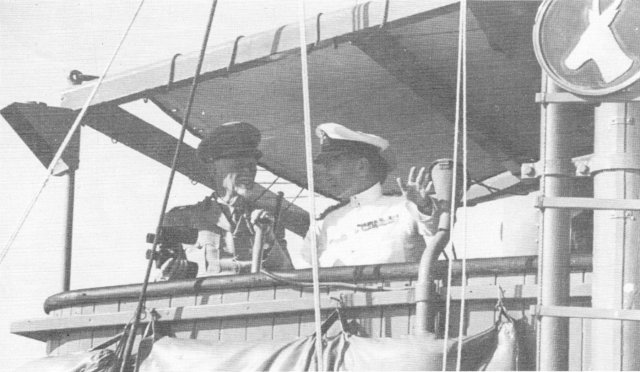

 The South African
The South African
by F V Demartinis (ex SA 69947)
Commander Bisset in his reply expressed his appreciation for my information and readily accepted my explanation of how the error had come about.
When units of the surrendered Italian Navy were anchored outside Alexandria harbour the minesweeper Langlaagte had been chosen to carry about a dozen VIPs, including the king of Greece, General Smuts and Admiral Sir John Cunningham on a tour of inspection of those ships. The crew of the Langlaagte had made their ship spotless for the occasion and had borrowed our springbok badge to place in front of their bridge. The accompanying photograph of General Smuts and Admiral Cunningham on the bridge of the Langlaagte may account for the assumption that the badge belonged to that ship. Incidentally, apart from its work in the Mediterranean, HMSAS Seksern saw service in the Aegean Sea.

Seksern's ship's company at Benghazi, 1943 (Author on extreme left, middle row)

HMSAS Seksern at Alexandria, 1943

Seksern's ship's company in Greek waters, 1944-45

General Smuts and Admiral Cunningham on the bridge of HMSAS Langlaagte,
with springbok badge borrowed from HMSAS Seksern on foremast
During 2006 Mr Bob McCall wrote offering some newspaper clippings about the doings of some of the "little ships' in the Mediterranean - his father having been on one of those ships. These clippings turned out to be hard to read but the best scans available at present are offered below for readers' interest. They appear to be from Cape Town newspapers and their column structure has been flattened out for easier reading.
If anybody has better versions, please send them (or simply the corrections) to scribe@samilitaryhistory.org
Gallantry on S. Africa's Little Ships
THE King has approved the following awards and decorations to officers and men of H.M.S.A. Ships Bever and Parktown, for bravery in the withdrawal from Tobruk last June. (Bever and Parktown were South-African minesweepers attached to the Mediterranean Fleet. Parktown was unfortunately sunk during this operation):
D.S.O
Sub-Lieutenant Ernest Rowland Frances (H.M.S.A.S. Parktown).
Comes from Krugersdorp. Age 34. Was in Training Ship General
Botha, 1923-23. Badly wounded during Tobruk withdrawal.
D.S.C.
Lieutenant Peter Allan North (H.M.S.A.S. Bever).
Comes from Amanzimtoti. Natal. Age 28.
Before the war employed in Geduld Mine. Rand. Served in
Training Ship General Botha.
D.S.M.
No. 69628. Petty Officer Alan Sidney Hargreaves (H.M.S.A.S. Bever).
Home address, 8. Worcester-road. Sea Point. Age 26. Served in
Training Ship General Botha.
No 66921. Leading-Stoker John Charles Rohlandt (H.M.S.A.S. Parktown).
Home. address, 12, Hillyard-street. Woodstock.
No 71431. Leading-Stoker Leslie Ronald Mitchell (H.M.S.A.S. Parktown).
Home address. 16, Wesley-street. Observatory. Before war was
employed by Customs Department, Cape Town
No. 71048. Able-Seaman George Kirkwood (H.M.SA.S. Parktown).
Comes from Maraisburg. Transvaal. Was a miner in peace time.
Mentioned in Dispatches
(Posthumous)
Lieutenant Leslie James Jagger (H.M.S.A.S. Parktown) Came
from Johannesburg, was killed during this operation.
Mentioned in Dispatches
No. 132522. Engine-room Artificer Alexander James McCall
(H.M.S.A.S. Bever) Home address, 7, Antrim-road Three
Anchor Bay. Engineer in private life
No. 71464. Stoker Andrew Henry Jooste (H.M.S.A.S. Parktown)
Comes from Vrededorp Johannesburg. Age 21. A gold miner
before joining Seaward Defence.
NAVAL AWARDS
Four Cape Town men in H.M.S. Parktown and Bever have won, awards for gallantry in the Mediterranean in June.
Three of them were awarded the Distinguished Service Medal.
They are: Petty-Officer Alan Sidney Hargreaves,(Bever) of 6,
Inez-road, Sea Point;
Leading-Stoker John Charles Rohlandt
(Parktown ), of 12, Hillyard-street, Woodstock;
and
Leading - Stoker Leslie Ronald Mitchell (Parktown).
of 16, Wesley-street, Observatory.
Engine-room Artificer, Alexander James McCall (Bever) of 7,
Antrim-road, Three Anchor Bay, was mentioned in dispatches.
H.M.S.A.S. BEVER LOST
SUNK BY MINE IN THE MEDITERRANEAN
ONE OF GALLANT "LITTLE SHIPS"
The following official announcement was issued today:
The Minister of Defence regrets to announce the loss
in the Mediterranean of H.M.S.A.S. Bever as the result
of striking a mine.
"The next of kin have been advised."
{too poor to scan......}
The others were the anti-submarine ship Southern Floe,
which struck a mine near Tobruk and was lost with all
hands but one in January 1941; the minesweeper Parktown, sunk
in action with aircraft and E-boats near Tobruk in June 1942,
with some loss of life, and the minesweeper Sudostlandet,
wrecked on the Natal coast early in the war with no loss of life.
MEDITERRANEAN SERVICE
The Bever had been in the Mediterranean for about three years and had earned fame and distinction. She was a former {N............} and converted into a warship at a Union port early in the war. Her complement, when she was commissioned, included many Cape Town men.
Her crew is believed to have numbered between 20 and ... She is best remembered for her escape from Tobruk in June, 1942. She and the Parktown stayed behind to pick up demolition parties long after German armoured forces had appeared on each side of the harbour entrance and they were among the last ships to leave.
They had to run the gauntlet of fierce fire from tanks and machine guns as they made for the open sea. Both ships were hit repeatedly but they got through.
FOUGHT OFF ENEMY
The next morning the Parktown was overwhelmed in a fierce attack by aircraft and E-boats, but the Bever fought off her assailants and reached Alexandria safely.
Her commanding officer, Lieut Peter North, of Amanzimtoti, Natal, was awarded the D.S.C. Petty Officer Alan Hargreaves of Sea Point was given the D.S.M. and Engine-room Artificer Alexander McCall of Three Anchor Bay was mentioned in dispatches for heroism and devotion to duty during this trip.
Since then the Bever has taken part in many other operations. She helped to sweep the North African coast clear of mines as the Eighth Army pushed Rommel towards Tunisia, and more recently she participated in the operations in the Aegean Sea.
{.................}
OF TOBRUK
"IT WAS LIKE HELL," WRITES FORMER
SEA POINT H.S. BOY
A vivid account of the fighting at Tobruk is contained in a letter to his parents by Stoker Petty Officer S.P.O. Turner, an old boy of The Sea Point High School and a member of the Municipal Cleansing Department staff before the war.
His ship spent six weeks in all at Tobruk, and the letter was written when it arrived at Alexandria after the fall of Tobruk. "At the end of the fifth week we had been there, Jerry started a terrific push which carried him through almost to Tobruk. We had some very nasty air raids, but the warning came one night when a shell whistled over us and landed behind the town. We knew then that they had brought up big guns and were going to shell us out of the place.
"Our ship and our partner ship continued their work through a week of this shelling and I can assure you it was very uncomfortable.
"Then we were informed that Tobruk was besieged, as Jerry had completely surrounded us."
"AS LONG AS I LIVE"
"On Saturday, June 2O, it happened, and that date will be
impressed on my memory as long as I live.
It was early morning and we were just pulling away to start our
daily job, when the shells started coming over with a vengeance.
"They had found their range and planted their shots just where they wanted them, in the town, on the quay, round the wrecks, at the oil berth - and we were sailing along with this lot falling around us:
"Then bombers appeared on the scene. We went out, did our job, and
returned to our anchorage.
"This went on until about three clock in the afternoon. The target
area was mostly the quay and wharfs.
"UNDER A HAIL OF SHELLS"
"Then Stukas appeared over the hill and started giving our troops
the works. It was like hell. Shells, level bombing and dive-bombing
- and there we were at anchor in the centre of it all, expecting any
moment to stop something and be blown sky high.
"At about four o'cock Jerry broke through our lines and our lads had to retire. This was all done in an orderly manner, and they burned everything they had to abandon.
"Then we received orders to go to the quay, which all the available ships did and picked up what men we could under a hail of shells.
"As we pulled away, a shell got us in the funnel. The quay was blown up and Jerry tanks entered the town.
"Sandy and I, down in the engine room, gave her all she had and she never travelled faster in her life.
"Meanwhile a motor launch laid smoke screen for us. Jerry tanks opened up on us from the shore and in all we received four hits by explosive shells.
"It was a miracle that we were not blown to bits, because the tanks along the shore were following us with their fire. At the harbour entrance the fire was even more concentrated and only God Himself took us past that.
"We lost the steward in our dash. As he tried to help a man out of the water into the boat, an exploding shell killed him".
He goes on to say that the ship was out of range of the guns by 10 o'clock, but there was still danger from submarines and following Stukas.
PARTNER SHIP SUNK
At Mersa Matruh the ship waited for the others. Her partner ship had been attacked by Italian "E" boats and sunk. A few survivors were picked up after being in the water for 10 hours.
Turner's ship eventually reached Alexandria.
"The last I saw of Tobruk" concludes Stoker Petty-Officer Turner "was flashes and flames and a great pall of smoke on the horizon, as the troops continued giving Jerry everything they had till the end."
S.A.MINESWEEPER'S
GALLANT END
PARKTOWN AT TOBRUK
THE gallantry of South Africa's little ships during the Tobruk evacuation last June. for which the King's awards have just been announced, was described in the following account of the engagement in which the minesweeper Parktown was sunk.
Battle-scarred Tobruk is once again in Allied hands. The harbour is filled with ships, and in a recent broadcast an airman said it was difficult, at first glance, to realise that they were all wrecks.
One charred wreck, now lying in deep water outside Tobruk, is of particular interest to South Africans. It is the remains of the South African minesweeper Parktown, which came to grief during the Tobruk evacuation last June.
Little has been heard of this engagement, although it was probably one of the fiercest fights with the enemy that the gallant lads of the South African Naval Forces have fought in this war.
It was only last week that the Kings awards for bravery in connection with this engagement were announced. They were one D.S.O., one D.S.C., four D.S.M.s and three mentioned in dispatches.
TINY SHIPS
Here, briefly, is the story of what the young South African seamen were up against last June when Tobruk was suddenly overwhelmed by the Germans.
On the fateful day when enemy tanks broke through the eastern perimeter of Tobruk three minesweepers lay in Tobruk harbour, of which two were the tiny South African ships Parktown and Bever.
Both vessels received order to embark as many men as possible from shore and to await sailing orders. Late that afternoon Bever was instructed to sail.
Heaviy laden with [men] clinging to all parts of ship, Bever put to sea. [By] that time at least six German tanks had taken up a position on shore with their [guns] covering the harbour. As [soon]as Bever began to move [she] was heavily engaged by the tanks and received several direct hits.
The ship's commander, who was awarded the D.S.C., decided to take the ship out himself and ordered all men below decks.
AIR ATTACK
The only man who disobeyed was a steward who came on
deck to help a soldier who trying to climb aboard. At [that]
moment ahother tank shell came inboad, killing the steward [and]
the soldier instantly.
Eventually Bever got clear [of] the harbour, but her troubles were not over. She was attacked by German aircraft but with ll her guns blazing she finally beat off the bombers.
Later she reached Mersa Matruh with holes through her funnels, with mast rigging shot away and riddled with splinter holes. Parktown was the next to leave Tobruk with hundreds of the men from the garrison aboard.
TUG IN TOW
She too was heavily engaged by the tanks but manage
get clear of the harbour with only superficial damage.
Just outside the harbour [she] came across a small tug, [full]
of men, which had broken down when trying to escape.
She, took the tug in tow, which seriously reduced her speed.
At dawn next day Parktown was discovered by German aircraft which repotted her position to E-boat. Shortly afterwards four E-boat appeard and attacked immediately.
A fierce running fight ensued in which the commanding officer was killed and a sub-lieutenant had his leg blown off. The former has received posthumous mention in dispatches and the latter has been awarded the D.S.O.
Parktown continued to {........} the E-boats until all her ammunition was expended. By that time however, she had been set on fire. With the vessel blazing from stem to stern, the men took to the rafts and were in the water for many hours. Eventually they were rescued by coastal motor boats and taken to Mersa Matruh.
Queries to Bob McCall - mim@new.co.za - who has copyright.
Return to Journal Index OR Society's Home page
South African Military History Society / scribe@samilitaryhistory.org